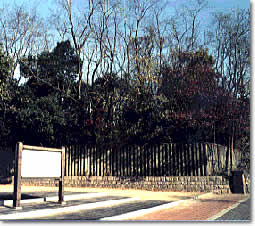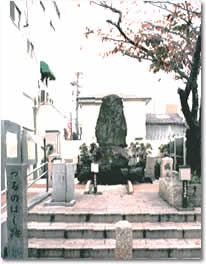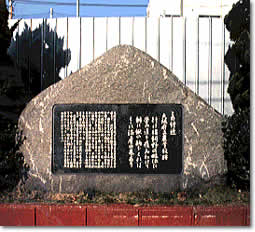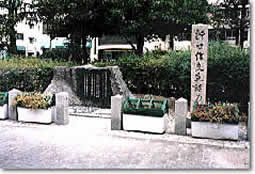|
|
| Spot |
| Okachiyama Kofun (ancient burial mound) |  |
| Location: 3-16 Katsuyama-Kita, Ikuno-ku | |
| Access: 2 minutes walk to the east from the bus station Ikuno Civic Center | |
| This ancient burial mound has been known
as Okachiyama (Victory Hill) since 1615 when Hidetada Tokugawa, the
second Tokugawa Shogun, held a banquet here in celebration of the
fall of Osaka Castle and the victory of the Shogunate over the Toyotomi
clan. Before that it was called Okayama. The burial mound is about 8 m high, and extended 112 m from north to south and 55 m from east to west, square at the head and round at the foot. The square head part is now traversed by a road (Katsuyama-dori) and Katsuyama-Minami Park, and only the round part at the foot remains. Okachiyama, Chausuyama (in Tennoji-ku) and Tezukayama (in Sumiyoshi-ku) are the three major ancient burial mounds in Osaka City. Okachiyama Kofun is said to be the tomb of Oohaseno Mikoto, who was the founding father of the Nakatomi clan, although there is no record to prove it. |
| Katsuyama Remains |
| Location: 3-16 Katsuyama-Kita, Ikuno-ku |
| Access: 2 minutes walk to the east from the bus station Ikuno Ward Office |
| Among the Jomon period sites in Osaka
City, Morinomiya Remains in Chuo-ku used to be considered the oldest,
dating back to the mid-to-late Jomon period (around 4000 B.C.). However,
during the excavations conducted near Okachiyama Kofun in October
and November 1990, several shards of earthenware were discovered which
were ascribed to the early Jomon Period (around 5000 B.C.). The excavation
site was named Katsuyama Remains. The excavated shards show that perhaps bivalve shells were used in decorating earthen vessels. The patterns on the surface of the shards include C shapes, D shapes and circular streaks. C and D shapes seems to have been made by pressing the inner and outer sides of split bamboos on the surfaces. Perhaps bivalve shells were used to draw the circular streaks. The C and D shapes are similar to those on the Awazu type earthen vessels, which were found in Awazu shell mounds in Shiga Prefecture. Earthenware shards with C and D patterns had not been found in Osaka Prefecture before 1990. Shards with circular streaks are considered to be related to the Tenjinyama type earthenware found in the Tokai district. These shards show that people around 5000 B.C. traveled extensively and exchanged ideas. |
| Tsurunohashi Site Park |  |
| Location: 3-17 Momodani, Ikuno-ku | |
| Access: 7 minutes walk to the east from JR Momodani Station | |
| This park is the site of Tsurunohasi (Crane Bridge). The bridge derived its name from the fact that cranes used to gather around here. It is also said that the bridge was the former Inoamazu Bridge built over the Kudara River in 323 A.D. "Nihon Shoki" (Chronicles of Japan), the oldest book on Japanese history, compiled in the 8th century, records as an event in November of the 14th year of the reign of Emperor Nintoku that the bridge was constructed here and that the place was named Obashi (Small Bridge). Inoamazu Bridge was the oldest bridge in Japan ever recorded in a document. Tsurunohashi used to span the Hirano River and served as an important part of the traffic route (the Momodani and Tsuruhashi Highway) between the Kawachi and Yamato districts. In 1940, however, the new Hirano Canal was excavated to replace the river and the bridge was demolished. A granite monument and four bridge piers were left to mark the bridge site. The site was designated as Tsurunohashi Site Park in April 1997. |
| Monument to Osaka Prefectural Agricultural School |  |
| Location: 3-13-30 Katsuyama-Kita, Ikuno-ku (Ikuno Civic Center) | |
| Access: Bus station Ikuno Civic Center | |
| Osaka Prefectural Agricultural School, forerunner of the present faculty of agriculture of Osaka Prefectural University, was founded in 1888 as one of the first schools in Japan for the education of leaders of agriculture. The school started in Sakai City and was relocated to this site in November 1890. The wooden Western-style school buildings were very much admired because of their elegance. The school site covered about 142,158 m2, encompassing the present 3-chome Katsuyama-Kita and 3-chome Katsuyama-Minami. In 1926, the school was relocated again to Sakai City because of the urbanization of this area. The former school premises are now the center of Ikuno-ku, together with the Ward Office, Katsuyama Office of the Fire Station, Ikuno Police Station and several schools. |
| Monument to Origuchi Shinobu |  |
| Location: 3-3 Katsuyama-Minami, Ikuno-ku (Okachiyama Mimami Park) | |
| Access: 1 minute walk to the east from the bus station Ikuno Civic Center | |
| Dr. Origuchi Shinobu (1887
- 1957), who was born in Naniwa-ku, was a distinguished scholar of
Japanese literature, especially "Manyoshu," the first anthology
of tanka (thirty-one syllable verses) compiled in the 8th century.
Dr. Origuchi was also famous as a tanka poet under the nom de plume
of Shaku Choku. Even as a student of Tennoji Middle School in the
late Meiji Era, he was well versed in Japanese classics and well acquainted
with noted places of historic associations in Osaka and its vicinity.
It is said that he would often walk around here with his friends after
school and on holidays. As a poet, he left many famous tanka, among which are depictions of Kudarano (old name of the Osaka Plain). In one of them, Shaku Choku the poet says that even thorny shrubs along the roads in Kudarano remind us of ancient times. On the monument to Origuchi Shinobu is engraved his tanka expressing poetic sentiments on a centuries-old road running through Ikuno from Obashi to Tsurunohashi. |